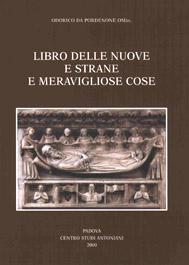Libro delle nuove e strane e meravigliose cose. Volgarizzamento italiano del secolo XIV dell'Itinerarium di Odorico da Pordenone.

Nota: L'acquisto on-line verrà gestito attraverso il sito LIBRERIA DEL SANTO. Il volume può essere richiesto anche direttamente al Centro Studi Antoniani inviando una email a info@centrostudiantoniani.it
Il Libro delle nuove e strane e meravigliose cose è una traduzione dell'Itinerarium di Odorico da Pordenone nella stesura di Guglielmo da Solagna, realizzata con ogni probabilità a Venezia attorno alla metà del secolo XIV. Viene qui presentato il testo edito criticamente in una versione di tale volgarizzamento di area toscana leggermente più tarda. Odorico da Pordenone (1270? - 1331), beato, è noto tra gli studiosi per il resoconto del suo viaggio in Estremo Oriente, viaggio di poco posteriore a quello di Marco Polo. Le memorie di questa esperienza sono custodite nell'Itinerarium, rapporto veridico e dettagliato di un viaggio reale attraverso paesi sconosciuti e affascinanti, un diario di viaggio e assieme un trattato geografico e commerciale.
This volume represents a new intervention by Alvise Andreose, the young and promising scholar in the field of Romance philological studies on The book of new, strange and wonderful things, a translation of the Itinerarium by the Franciscan monk Odorico of Pordenone (+1331) in the version of his companion, friar Guglielmo da Solagna, which in all probability was published around the middle of the XIV century in Venice. The curator of the edition carried out an indirect analysis on the text and history of the Itinerarium during its various vicissitudes throughout the centuries, creating an accurate biographical and bibliographical note on Odorico and a careful comparative analysis of the language and syntax among the eight witnesses who helped in the reconstruction, which has now been sufficiently approximated, of the original text. Odorico of Pordenone died in the convent of Saint Francis of Udine on January 14, 1331. He was seen by many as a follower of Marco Polo, who travelled in India and China, and who was the first to arrive in Borneo. Besides being a traveller, he was above all an indefatigable missionary, who left for the Orient to convert infidels, thus contributing to the work of evangelisation that the Inferior friars were carrying out in those lands, and showing a sufficiently complete picture of the state of Franciscan missions in the great Empire of the Yuan Dynasty. The description of his travels, which was widely diffused in medieval times, symbolically became the "image" of the time, in the public eye, of the itinerary Christians follow through the seductions of the world, to reach heavenly blessedness.
Archivum Franciscanum Historicum, fasc. 3-4, anno 94, 2001
Collectanea Franciscana, vol. 71, 2001
Medioevo Latino, XXII, 2001

